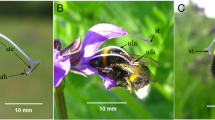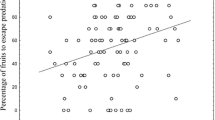Abstract.
In insect-pollinated plants flowers must balance the benefits of attracting pollinators with the cost of attracting natural enemies, when these respond to floral traits. This dilemma can have important evolutionary consequences for mating-system evolution and polymorphisms for floral traits. We investigate the benefits and risks associated with flower size and sex morph variation in Dianthus sylvestris, a gynodioecious species with pistillate flowers that are much smaller than perfect flowers. We found that this species is mainly pollinated by nocturnal pollinators, probably moths of the genus Hadena, that also oviposit in flowers and whose caterpillars feed on developing fruits and seeds. Hadena preferred larger flowers as oviposition sites, and flowers in which Hadena had deposited eggs bore more pollen on their stigmas, suggesting that Hadena is indeed the principle pollinator, or that pollinators and these seed predators employ the same choice criteria for flowers. Globally, perfect flowers suffered more predation by seed predators than did pistillate flowers, suggesting that seed predators play an important role in reproductive system dynamics in this species. On the other hand, female flowers were more likely to be contaminated with spores of another natural enemy, the pathogenic fungus Microbotryum violaceum, that are transmitted by pollinating insects. This complex interplay between two natural enemies, one of which, Hadena, is also a pollinator and vector of fungal spores, may contribute to the maintenance of the polymorphic reproductive system of the host plant.
Similar content being viewed by others
Author information
Authors and Affiliations
Corresponding author
Additional information
Electronic Publication
Rights and permissions
About this article
Cite this article
Collin, C., Pennings, P., Rueffler, C. et al. Natural enemies and sex: how seed predators and pathogens contribute to sex-differential reproductive success in a gynodioecious plant. Oecologia 131, 94–102 (2002). https://doi.org/10.1007/s00442-001-0854-8
Received:
Accepted:
Published:
Issue Date:
DOI: https://doi.org/10.1007/s00442-001-0854-8




